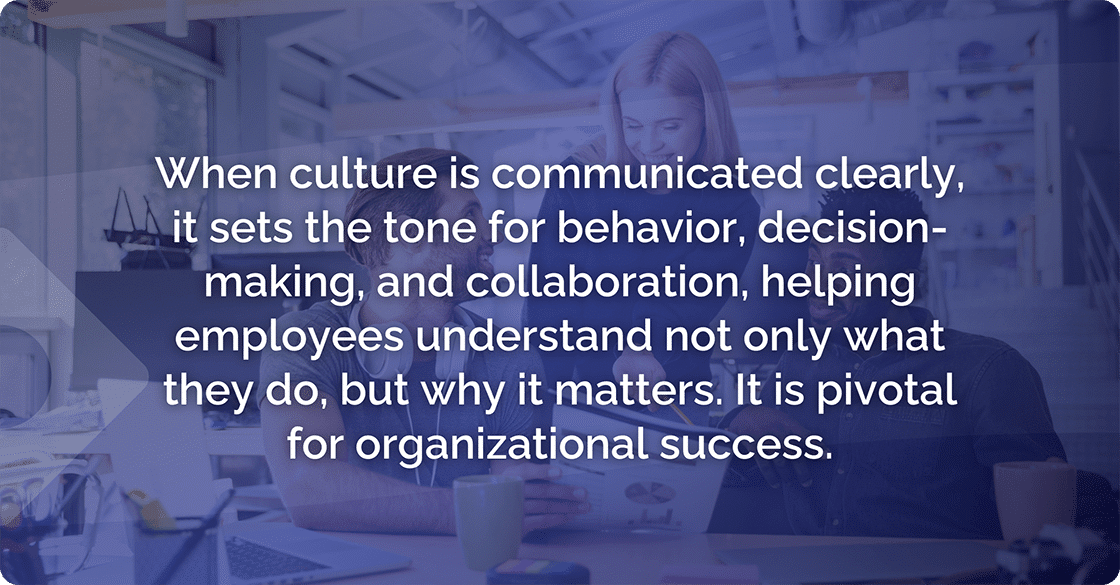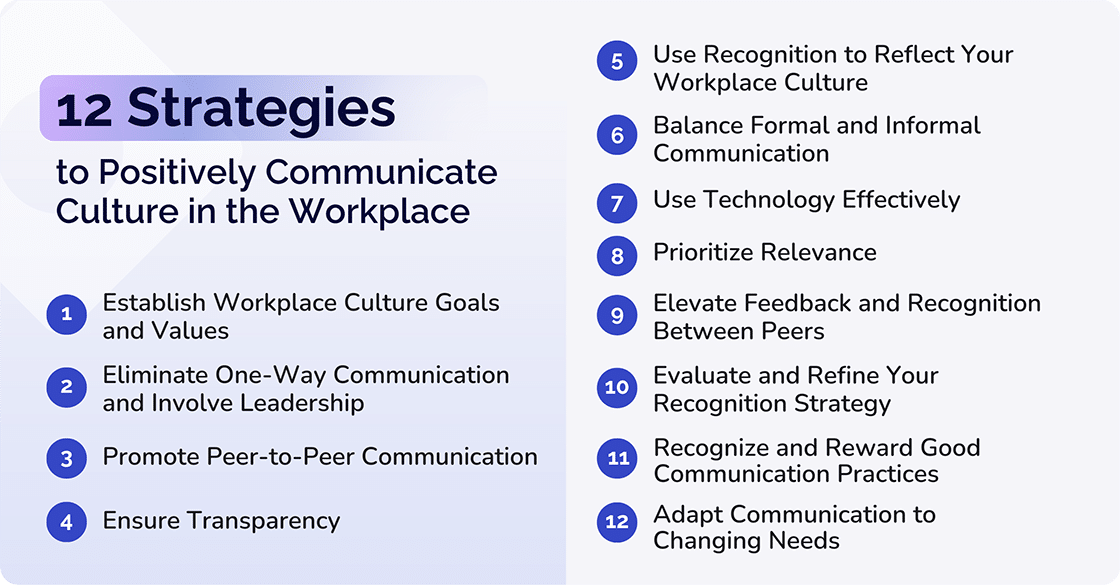 Strategic Communication Examples
Strategic Communication Examples
12 Tips on How to Effectively Communicate Culture in the Workplace
Do you know how to communicate culture to employees? Learn all about communication culture and how to use it effectively in the workplace.

.png)
Employee Experience Journey Mapping
Start transforming your employee experience today. Download your free Employee Experience Journey Mapping Template now! Access Now
Access NowEffectively communicating workplace culture is essential to fostering a cohesive and engaged workforce. Strong company culture communication gives employees a sense of purpose and belonging, aligning them with the organization’s values and mission. When culture is communicated clearly, it sets the tone for behavior, decision-making, and collaboration, helping employees understand not only what they do but why it matters. It is pivotal for organizational success.

Company culture communication is more than just a one-time message. It requires consistent and intentional effort. Leaders must regularly reinforce cultural values through clear and authentic communication across various channels, including newsletters, meetings, and digital platforms. By making culture an integral part of the conversation, companies can create a workplace where employees feel connected, motivated, and committed to shared organizational goals.
According to Gallup’s 2025 State of the Global Workplace report, engagement is on the brink. Globally, 79% of employees worldwide feel that they are either not engaged (62%) or actively disengaged (17%). This highlights the need to improve communication strategies to foster a stronger workplace culture.
The report provides insight into the fact that many organizations didn’t start with high levels of employee engagement. Rather, building a highly engaged organization is usually a deliberate, multi-year effort driven by leadership.
The report also highlights the importance of company culture. Leaders who cultivate a strong and resilient culture within the workplace prioritize key elements that distinguish them from other organizations.
“Some organizations are already there. When leaders build a company culture around employee engagement, following science-based management practices, the result is higher productivity and profitability.” Gallup 2025
What is Communication Culture?
We’re going to look more closely at communication culture before we examine its impact on organizational success.
Strong company culture communication in the workplace refers to the set of shared practices, norms, and values that shape how individuals and teams communicate within an organization. It encompasses how information is shared, the tone and style of interactions, preferred communication channels, and the level of openness, transparency, and feedback. A strong communication culture promotes clarity, collaboration, and trust, ensuring that messages are effectively conveyed and understood across all levels of an organization.
Intercultural communication plays a vital role in shaping and enriching a communication culture, particularly in diverse and globalized organizations. It focuses on how people from different cultural backgrounds interact, emphasizing the need for awareness and sensitivity to varying communication styles, values, and norms. This type of communication is closely intertwined with diversity, equity, and inclusion (DEI) as it facilitates understanding and effective interaction among individuals from diverse backgrounds. It also promotes inclusivity, ensuring diverse voices are respected and equitably represented in communication.
When integrated into communication culture, intercultural communication helps create an environment where diverse perspectives are respected and understood, fostering inclusivity and collaboration. By recognizing and adapting to cultural differences, organizations can enhance clarity, reduce misunderstandings, and build a more cohesive, culturally aware workforce.
Free Employee Experience Journey Mapping Template to Transform Your Workforce Engagement
Embrace journey mapping and transform employee satisfaction and engagement into a data-driven strategy.

Download Free
Impact of Internal Communication on Workplace Culture and Business Growth
A strong communication culture is closely tied to organizational success. Clear, open communication strengthens team relationships and reduces absenteeism, further driving productivity and fostering a healthy workplace.
Gallup collaborates annually with Workhuman, a multinational company renowned for pioneering the human workplace for more than 20 years. Workhuman’s primary focus is peer-to-peer recognition, which helps drive employee engagement, productivity, and retention.
The Gallup | Workhuman 2024 report, The Human-Centered Workplace: Building Organizational Cultures That Thrive, reinforces this connection. Their research highlights how communication shapes an employee’s daily experience and strongly influences how they describe their workplace culture. Engaged employees use positive descriptors like caring, friendly, fun, integrity, innovative, inclusive, service, quality, and professional. In contrast, actively disengaged employees use drastically different terms — toxic, disorganized, money-driven, stressful, horrible, or chaotic — underscoring how quickly unclear or inconsistent communication can erode culture.
The report notes that disengagement rises when employees lack clarity, connection, or recognition. As it suggests, culture is the soul of an organization, and communication is one of the most powerful tools leaders have to protect and strengthen that culture.
Strong internal communication doesn’t just improve the employee experience — it accelerates business growth. When employees understand priorities and see how their work contributes to shared goals, execution becomes faster, alignment improves, and decision-making strengthens. Clear communication also reduces friction between teams, supports innovation, and improves retention, all of which directly contribute to long-term performance and competitive advantage.
Employee Alignment
Good communication helps align employees with the company’s mission, goals, values, and company culture. This alignment enhances collaboration and ensures that everyone is working toward shared objectives.
Research indicates that employees rank strategic alignment as a primary goal of their internal communication efforts. It generally also highlights the importance of fostering culture and belonging as a key objective for internal communication strategies.
Increased Productivity
When employees know their roles and the company’s objectives, they work more efficiently and make informed decisions. Additionally, effective communication ensures employees are aligned with organizational goals, boosting morale and efficiency.
Gallup’s ongoing research shows that businesses with engaged employees experience a significant increase in productivity. There is no doubt that effective communication plays a critical role in achieving this by providing clarity and alignment around organizational objectives.
Stronger Employee Engagement
Apart from anything else, effective communication fosters a sense of belonging and motivation. It is also key to driving engagement.
Gallup’s State of the Global Workplace report reveals that globally, employee engagement has continued to fall since 2021. But they emphasize how relatively simple it is for employers to improve engagement.
“Employees can become engaged when their basic needs are met, and they have a chance to contribute, a sense of belonging, and opportunities to learn and grow.” Gallup
Employee Experience
Strong communication enhances the employee experience by ensuring that staff feel valued, informed, and supported. Furthermore, when employees feel connected to the culture, their experience improves significantly. This positive experience leads to greater job satisfaction and a stronger sense of belonging.
The Gallup | Workhuman 2024 Human-Centered Workplace report maintains that the foundation of a new 21st-century era of work must become “an intentional focus on the employee experience.” Without it, organizations simply won’t succeed.
Employee Retention
Effective culture communication helps build loyalty and trust, reducing turnover as employees are more likely to stay with a company that fosters transparency and engagement. It is also true to say that when employees feel informed and valued, they are more likely to stay. Strong communication reinforces a sense of belonging, directly contributing to improved employee retention by fostering long-term commitment to the organization.
Furthermore, research from Gallup and Workhuman confirms that when implemented with intention and backing from employees, strategic recognition can help facilitate drastic, long-lasting improvements in retention and employee engagement. These benefits are critically important for sustained future success.
Free Employee Experience Journey Mapping Template to Transform Your Workforce Engagement
Embrace journey mapping and transform employee satisfaction and engagement into a data-driven strategy.

Download Free
Workplace Collaboration
Open communication encourages idea-sharing and collaboration, driving creativity and business innovation. Focusing on workplace collaboration ensures that employees can easily share ideas and work together on common goals.
A case study featured in McKinsey & Company’s Diversity Matters Even More describes what Air New Zealand has been doing with employee networks and collaboration. According to the airline’s Chief People Officer, Nikki Dines, ethnic inclusion remains a challenge, particularly in upper and middle management. To counteract this, Air NZ partnered with a community organization on a program designed to build leadership capability, stressing cultural confidence and providing space to discuss identity.
Brand Ambassadorship
Employees aligned with the company’s culture become natural brand ambassadors, sharing positive messages and boosting the company’s reputation externally. It stands to reason that when internal communication is clear and transparent, employees will feel proud to represent the company, improving both internal and external brand perception.
Safety and Compliance
Clear communication also plays a crucial role in safety and compliance. Organizations with good communication practices see a major decrease in safety incidents. Open communication ensures that employees are well-informed about safety protocols and compliance requirements, reducing risks and ensuring adherence to regulations.
Change Management
During periods of organizational change, effective communication is essential to minimize disruptions. Keeping employees informed reduces uncertainty and helps guide them through transitions.
Strong change communication ensures that employees understand the reasons for change, the expected outcomes, and their role in the process, fostering a smoother adaptation and greater acceptance. Effective change communication also builds trust, making it easier for employees to remain engaged and aligned with new organizational goals.
Improved Customer Satisfaction
A well-informed, engaged workforce is better equipped to deliver superior customer service, driving growth.

12 Strategies to Positively Communicate Culture in the Workplace
Effective workplace culture is built through communication that does more than share information. It creates clarity, belonging, and shared purpose. When employees feel informed, supported, and able to contribute, culture becomes something they experience every day rather than something they must interpret. These 12 strategies highlight practical ways to communicate your culture consistently and meaningfully.
#1 Establish Workplace Culture Goals and Values
Start with clearly defined culture goals that align with your broader business strategy. When employees understand what the organization values and how it expects people to work together, communication becomes more consistent and purposeful. Your mission explains what you do — your culture defines how you do it.
Gallup's 2025 workplace culture insights emphasize a need to evolve the "social compact" with employees by focusing on connection to meaning, well-being, and flexible work. Key goals for a high-performance culture include creating a sense of purpose, fostering inclusive environments, improving manager coaching, and implementing effective communication to address the challenges of low employee engagement and high burnout.
#2 Eliminate One-Way Communication and Involve Leadership
Shift from top-down messaging and encourage two-way conversations. This promotes transparency and ensures employees feel heard, creating a more inclusive environment. Two-way communication fosters mutual respect and helps build trust between leadership and employees, making employees feel more valued and engaged.
Leadership involvement in communication is also critical. Leaders should set the tone by modeling transparent and respectful communication, demonstrating that it’s an essential aspect of the company's culture. Employees are more likely to embrace cultural values when they see leaders actively practicing what they preach.
Remember that communication is not only about the flow of information but also about active engagement and setting a strong example from the top.
#3 Promote Peer-to-Peer Communication
Fostering a culture where employees collaborate enhances teamwork and innovation. Open peer communication leads to better problem-solving and collective ownership. By encouraging peer interaction, organizations build a collaborative culture where knowledge and ideas are shared freely.
Encouraging employees to collaborate and communicate with each other enhances teamwork, problem-solving, and innovation. Furthermore, peer exchange builds a culture of shared ownership, where ideas flow freely and solutions are co-created rather than handed down.
#4 Ensure Transparency
Honest and open communication builds trust within the workforce. Sharing both successes and challenges helps foster a sense of accountability and strengthens the organization's core values. Transparency also encourages employees to voice concerns openly, knowing that honesty is a key part of the company’s communication culture.
A 2025 Forbes article, Why Leadership Transparency Will Define Organizational Success In 2025, highlights the importance of redefining leadership transparency in the modern workplace.
“Leaders must shed the armor of traditional corporate communication and embrace a more authentic approach to leadership.” Forbes
#5 Use Recognition to Reflect Your Workplace Culture
Recognition reinforces communication culture by clarifying which behaviors and contributions matter most. When organizations acknowledge actions that reflect their values, employees gain a clearer understanding of what the culture expects. Recognition also strengthens morale, supports retention, and motivates employees to model the desired behaviors. Ensuring that recognition is aligned with your values — rather than based solely on performance metrics — helps shape a culture grounded in integrity, collaboration, and shared purpose.
#6 Balance Formal and Informal Communication
Maintaining a balance between corporate and casual communication allows employees to engage meaningfully. Formal settings can clarify objectives, while informal channels encourage creativity and personal connection. This balance helps employees feel comfortable in both professional and casual exchanges, enhancing overall communication.
Using different types of internal communication, such as formal emails and reports alongside casual chats or instant messaging, ensures that communication is both structured and flexible, catering to various employee needs.
#7 Use Technology Effectively
Technology like employee communication software, instant messaging, collaboration platforms, and employee portals can streamline communication. These tools make it easier to distribute important updates and foster daily interactions.
By leveraging different types of internal communication technologies, organizations can ensure that messages are delivered quickly, reaching the right people at the right time. Personalization capabilities, which allow tailored messaging to specific teams or individuals, further enhance communication by making it more relevant and engaging. This is a feature that significantly boosts employee satisfaction and connection to company culture and the company's goals.
#8 Prioritize Relevance
Employees are more likely to engage when internal communication feels meaningful and directly related to their work. Tailoring messages to specific teams, roles, locations, or interests creates relevance and reduces information overload. Relevant communication helps employees focus on what matters most, prevents disengagement, and shows respect for employees’ time and attention. This intentional targeting strengthens the connection between communication and culture.
#9 Elevate Feedback and Recognition Between Peers
Peer feedback and recognition can significantly strengthen culture because they reflect daily interactions and contributions that leaders may not always see. Encouraging coworkers to acknowledge each other’s efforts builds trust, encourages collaboration, and strengthens team relationships. It also promotes a culture of shared appreciation and continuous improvement. When peer recognition becomes common, employees feel more supported and valued by the people they work with most often.
#10 Evaluate and Refine Your Recognition Strategy
Recognition strategies should evolve as the organization grows and employee expectations shift. Regular evaluation helps ensure that recognition remains relevant, equitable, and aligned with cultural goals. Assessing who is being recognized, how recognition is delivered, and whether it reflects desired behaviors allows organizations to make improvements. This ensures recognition remains a meaningful and accurate reflection of the culture, not a static tradition.
#11 Recognize and Reward Good Communication Practices
If strong communication is an essential part of the culture, it should be acknowledged. Recognizing employees who communicate clearly, respond promptly, share information openly, or collaborate effectively reinforces the behaviors you want to see across the organization. This helps set expectations around communication norms and encourages others to follow them. Over time, this emphasis strengthens the cultural foundation of transparency, clarity, and teamwork.
#12 Adapt Communication to Changing Needs
Culture and communication in the workplace both evolve as the workforce, technologies, and business environment change. Organizations need to adapt communication methods, tone, frequency, and channels to meet shifting employee needs. Reviewing communication practices regularly ensures messages remain effective and that employees stay informed and connected. Adaptability also demonstrates that the organization is responsive and committed to supporting employees in real and relevant ways.

How Cerkl Broadcast Enhances Workplace Communication
Cerkl Broadcast streamlines internal communication with personalized, targeted messaging through its Audience Manager. This ensures that employees constantly receive relevant content. The mobile-friendly Broadcast platform allows easy access to information from any device, keeping teams connected on the go.
With advanced engagement analytics, organizations can track employee interaction, measure communication effectiveness, and continuously refine their strategies. Additionally, Cerkl's new Blast Translations feature enables seamless communication across language barriers, making it easier for global teams to stay informed.
Overall, Cerkl Broadcast provides a comprehensive, data-driven solution that enhances communication and improves the employee experience.
What’s Next
Communicating culture effectively is one of the most influential parts of any internal communication strategy. It shapes how employees understand your values, how they experience their work, and how connected they feel to your organization. Strengthening your company culture communication means strengthening the employee experience, and that starts with seeing the journey through their eyes.
If you're ready to improve how employees engage with your communication culture at every stage, we encourage you to download our free Employee Experience Journey Mapping Template. It will help you visualize touchpoints, identify communication gaps, and design a more consistent, human-centered experience from onboarding to long-term growth.
Access the template FREE now and start mapping a stronger employee experience.

Free Employee Experience Journey Mapping Template to Transform Your Workforce Engagement
Embrace journey mapping and transform employee satisfaction and engagement into a data-driven strategy.







